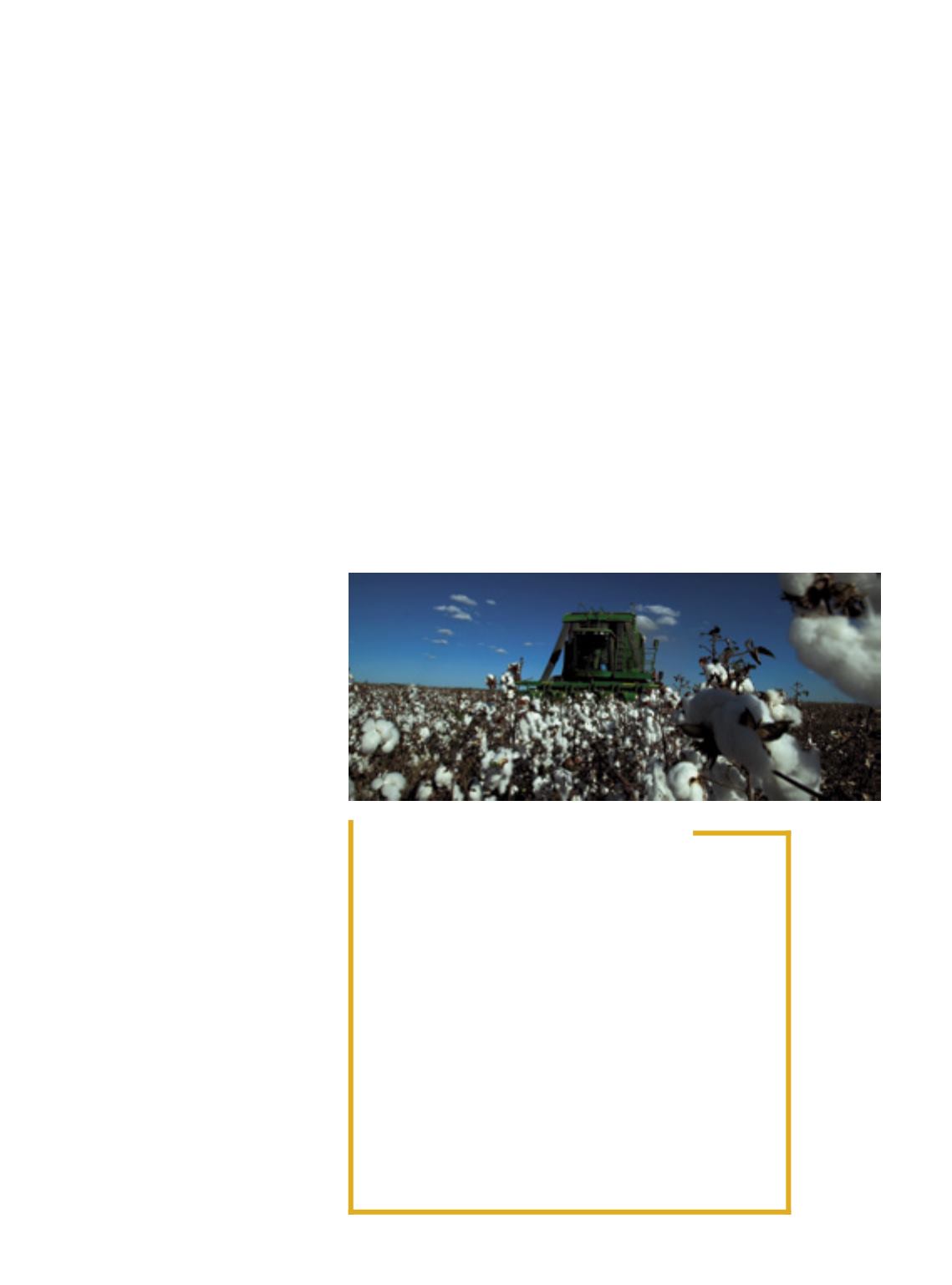
All
beauty
Cotton farmingwas one of the fewactivities
inBrazil that generated revenue in agribusiness
in 2017, and there are good perspectives for 2018
l
INTERNATIONAL SCENARIO
Intheinternationalscenario,the2017/18cropisestimatedat26.1mil-
lion tons, 12.6 percent up fromthe previous year, according to theUSDe-
partmentofAgriculture(USDA).China,IndiaandtheUnitedStatesexpand-
ed their plantedareas. In two years, production jumps 5.2million tons, or
24.8 percent. In the meantime, global consumption is projected to reach
26.05milliontons,up4.2percent,thehighestsincethe2007/08cropyear.
The leading consumer countries have increased their consumption
further, due to their flourishing economies. In five years, global consump-
tion went up 8.7 percent. Although production is outstripping demand,
the final stock/consumption relation should drop to 73.6 percent (in the
2014/15 crop year it was 100 percent), according to the report. China
used todetain60percent of the stocks andnowdetainsonly45percent.
Itsavailablecottonstocksareenoughforoneyearoftheinternaldemand,
whileinthe2014/15cropyearthesestockswereenoughfortheconsump-
tion of two years. These are arguments that are a good aid for favorable
priceperspectivesin2018.
C
otton farming in Brazil in the
2016/17 crop year was good
business, one of the rare invest-
ments in agriculture that gen-
erated profits. The scenario for
2018 should continue favorable. The net prof-
itmarginper hectare remainedatR$1.3 thou-
sand per hectare of harvested lint. This is the
unanimous evaluation by the national supply
chain, which comprises about one thousand
farmers, uses high technology and has deep
knowledge of cultivation processes, manage-
ment,harvestandcommercialization.
“It is a very professional sector, which is
now going through a resumption period driv-
enbyitsprofitability”,saysArlindodeAzevedo
Moura, president of the Brazilian Association
of Cotton Producers (Abrapa). Highly valued
in the international marketplace, cotton also
generated income at farmer level through the
sector’s strategy that consisted in anticipating
the purchase of the inputs and selling the lint
in anticipation in 2017, with delivery sched-
uledforthesecondhalfof2018.
Inthe2016/17growingseason,innumbers
released by the National Food Supply Agency
(Conab), Brazil produced 3.828 million tons
of seed cotton and 1.53 million tons of lint,
up nearly 18%, in 939 thousand hectares. The
good results led toplantedareaexpansions in
2017/18, to a total of 1.05million hectares, up
11.9percent. Productivity isestimated todrop
0.6 percent, from 4,076 to 4,053 kilograms of
seed cotton per hectare. The volume of the
crop is supposed tosoar 11.1percent, totaling
4.257million tons, equivalent to 1.703million
tonsoflint.PlantingstartedinDecember.
Moura believes in favorable commercial-
ization in 2018, but acknowledges that abun-
dant supplies have reflections on the mar-
ket. “It also depends on the behavior of the
stocks, supply and global demand, aswell as
on the global economy, but expectations of
thepresent scenarioarepromising”, he sum-
marizes. In 2017, Brazil exported 685 thou-
sand tons of lint, with 63 percent destined
for Asia. As of September, an inconvenience
surfaced: shipments began to suffer de-
lays of up to 30 days. There was a shortage
of containers. “It happened because Bra-
zil’s imports decreased. The situation was
mitigated through the use of ports like Sal-
vador, in Bahia. In 2018, Brazil is supposed
to import more products, and there will be
enough containers”, he explains.
Brazil’s internal availability is estimated
at 2.1 million tons, for a consumption of 720
thousand tons, up 4.3 percent from the previ-
ous year, according to Conab figures. The sur-
plus is estimated at 1.38 million tons. Exports
shouldamountto960thousandtons,pushing
up the stocks in early 2019 to more than 400
thousandtons.Exportshavesustainedremu-
nerating prices. That is why surpluses are a
cause for concern, as they could put limits to
the sector’s profits, according to a report by
the Center for Applied Studies on Advanced
Economics (Cepea), of the Luiz de Queiroz
Collegeof Agriculture (Esalq),adivisionofthe
UniversityofSãoPaulo(USP).
Sílvio Ávila
12


